
table of contents
- Characteristics
- Location
- floor
- plants
- to water
- Fertilize
- Cut
- Overwinter
- Multiplication
- Diseases
- Pests
Profile and care information open +conclude -
- Flower color
- yellow, pink, red
- Location
- Sunny
- Heyday
- June, July, August, September
- Growth habit
- upright, expansive
- height
- up to 8 m (outdoors), up to 2 m (pail)
- Soil type
- sandy, loamy
- Soil moisture
- moderately dry, fresh
- PH value
- neutral
- Limescale tolerance
- Calcium tolerant
- humus
- rich in humus
- Poisonous
- Yes
- Plant families
- Dog poison family, Apocynaceae
- Plant species
- Potted plants, Potted plants
- Garden style
- Terrace garden, pot garden, winter garden
The temple tree, frangipani or also called plumeria, is very popular due to its easy care and especially ideal for beginners as a hobby gardener. It enchants gardens, balconies and terraces with a pleasant, intense scent. It is available in the most beautiful flower colors. Despite the low demands that it places on its care, a few details must be observed so that it thrives splendidly and gives pleasure for many years.
Characteristics
- Name: Temple Tree
- Scientific name: Frangipani, Plumeria
- Family: Dog poison plants (Apocynaceae)
- Origin: South America, the Caribbean
- deciduous tree or shrub
- Plant height: up to eight meters in the open-air bed - up to two meters as a container plant
- Flowers: strongly scented in red, yellow or white
- Lime tolerance: lime tolerant
- Location: sunny, warm
- Not hardy
- Toxic: yes
Location

Due to its origin, a Frangipani is used to warm, sunny locations, which it needs for healthy, vigorous growth in the cooler Central European climate. The poisonous dog plant sets other important criteria for the optimal location, which must be taken into account before planting in the garden or tub.
- Light: at least five to six hours of sun per day - preferably direct sunlight
- ideal temperatures during the growing season: around 20 degrees Celsius daytime temperature
- sheltered from the wind
- avoid cold drafts
- The ideal location is in front of a south-facing wall or a light-flooded winter garden
Tip: If night temperatures drop below 15 degrees Celsius or there are strong fluctuations between day and night temperatures, it is advisable to use the The plant should be placed in a warmer location at night, for example in the house, as otherwise growth disorders will occur, especially when the flowers are forming can.
floor
Temple trees make certain demands on the soil in which they are planted / cultivated. The soil properties determine whether and how they will develop because the plants obtain their necessary supplies from the soil. The soil and substrate should have the following properties:
- nutritious
- permeable to water
- good looseness
- tolerates slightly calcareous soil
- sand and / or clay (better water storage)
- pH value: around 7
- not too damp
- ideally suited: cactus substrate, which is enriched with coarse sand
- The substrate should also contain perlite (more optimal water permeability)
plants
In the garden
If planting in the garden bed is desired, the best planting time is mid / late May, provided the temperatures are consistently at least 15 degrees Celsius.
Basically, when planting outdoors, it must be taken into account that the temple tree is not hardy and therefore before Planted out of the garden bed again at the beginning of winter and transplanted into a bucket for wintering in a warm place got to. Since frangipanis get much more space in the garden for their roots to spread, they grow depending on the variety can quickly get to a tree and, if necessary, be on more compact dimensions before "wintering" cut back. If you are not afraid of this effort, you should follow the instructions below when planting outdoors:
- Plant hole depth / width: so large that all roots fit into it without kinking
- Plant the root ball so deep that seven to ten centimeters of soil form a level border over it
- Place a two-centimeter-thick layer of gravel or quartz sand on the planting soil
- then add a layer of earth, if necessary with compost
- Place the plant in the center of the planting hole
- Close the planting hole with soil (ideally cactus soil)
- Lightly press / step on the earth
- Pour moderately
- Plant spacing: 1/2 of the growth width
In the bucket / pot
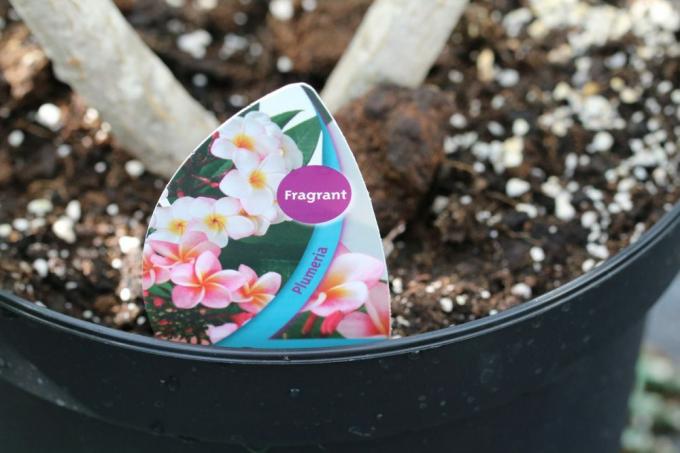
The best planting time for planting in a pot / tub is after the end of the resting phase around the end of March and before the start of the growing season in May. It should be noted that the plant can only go outside when the temperatures are higher, so this planting time is only optimal if a warm location is ensured.
Since the winter hardiness is only partially given, planting in a tub / pot is recommended because planting out / transplanting before The beginning of winter is often associated with damage to the fine roots and the plant, weakened, goes into the winter dormant phase leaves.
Bucket / pot material
A product made of smooth plastic should be used as a bucket / pot. The roots often anchor themselves to clay pots, so that repotting leads to root damage and resulting growth disorders. At the age of three or four years, a root cut is usually due, so that from this point onwards the older Frangipani can also be placed in a planter made of clay.
colour
Black plastic containers are advantageous because the color black provides more heat in the pot and allows it to be stored better. This is particularly beneficial for growth in spring, when the sun's rays are mostly weak.
size
The pot size is decisive for the height / width. The more space the roots have to expand, the larger a frangipani will be. With a pot diameter of 50 centimeters and a height of 30 centimeters, temple trees can grow up to well over two meters, depending on the variety. If you want to keep it smaller, choose a smaller pot, but you have to shorten the roots regularly. As a minimum, however, a vessel should always be at least twice as large as the ball of plants. For young plants, a pot size should be chosen that is sufficient for the first few years so that unnecessary repotting is not necessary.
Tip: It is important to ensure that a pot / bucket has a drainage hole on the bottom through which excess water can drain. Otherwise the risk of waterlogging increases, to which a temple tree can react quickly with root rot.
Potting
Potting is done in a similar way to planting in the garden. A drainage system is created from the same materials on the bottom of the pot, as described under "Plants - in the garden".
Repot
In the first years of a temple tree's life, repotting is not necessary as the roots develop slowly. If the soil is completely rooted after three or four years, repotting is advisable.
After that, it usually only needs to be implemented every five years. If the roots are not shortened, a larger planter should be selected. Fresh substrate ensures an optimal supply of nutrients to the plant.
Tip: In no case should it be repotted more often, as the process puts the temple tree under great stress and can react with unsightly leaf deformations and failure to flower.
to water
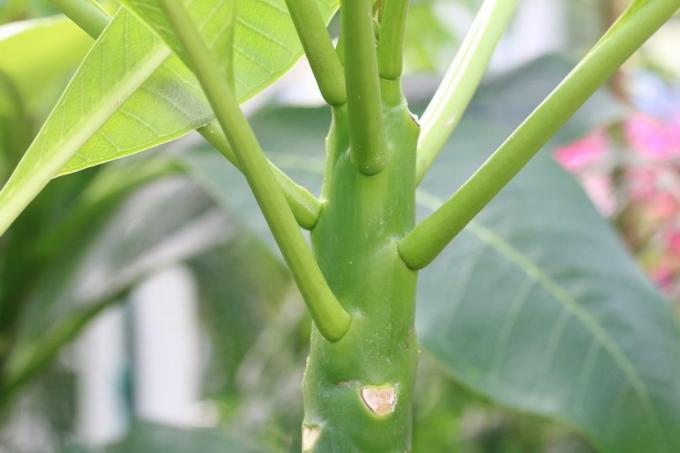
Sensitivity is required when watering temple trees. They neither like too much moisture, nor can they tolerate drought, which is quickly reached through high evaporation from the foliage. The pouring behavior must be adapted accordingly to the weather conditions and above all to the temperatures. The following points should be considered when watering:
- only water when the surface of the earth is dry (avoid drying out)
- In case of high summer temperatures, check the humidity at least twice a day and water if necessary
- low water requirement in winter (wrinkled trunk is a sign of too much drought)
- Avoid leaves when watering, as there is a risk of burns and the risk of infectious diseases increases
- If the soil contains lime, use lime-free water when pouring (for example from the rain barrel)
- Avoid pouring over - true to the motto "less is more"
- Pour off excess water after watering
Fertilize
Regular fertilization is part of perfect care from the time of budding until shortly before the start of the resting phase. The following instructions for the procedure ensure ideal fertilization:
- Fertilizer rhythm: every two weeks from May to around September
- use nitrogenous fertilizers for young plants (promotes growth)
- use fertilizers with a high phosphate content for older temple trees (improves flower formation)
- optimal: to apply liquid fertilizer with the irrigation water (fertilizer reaches the depths more reliably)
Cut
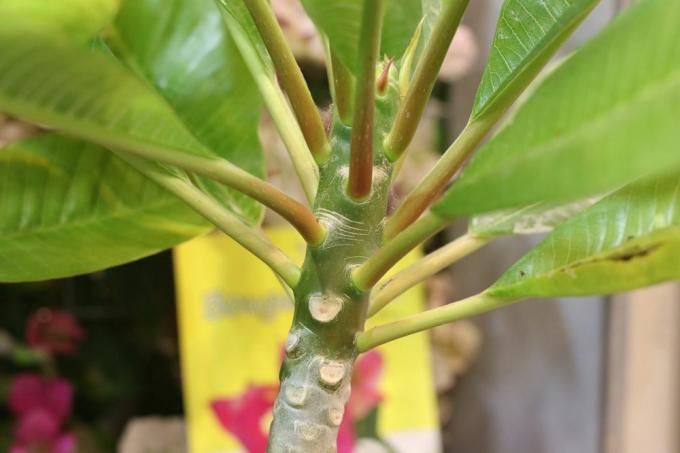
Best time
In the first few years of life, cutting is not part of regular maintenance. The best moment to allow the growth to proceed in a more controlled manner is when repotting in the spring. However, it is not absolutely necessary if the tree / shrub is developing splendidly. From September onwards, no pruning is allowed if the temple tree is splendid in the next season should bloom, because then the flower umbels are already formed, which may also be cut off will.
method
The roots can be shortened by a maximum of a quarter and the branches by a maximum of a third. Dried out root parts and shoots must be completely removed.
Freshly cut shoots offer the possibility of propagating cuttings. More on this under the heading "Propagation". Shortening the shoots encourages branching and allows the temple tree to grow denser.
Tip: When cutting, gloves must be worn in any case, because the sap in particular is poisonous. Cut off plant parts should be disposed of out of the reach of children and dogs due to their toxicity.
Overwinter
Due to its origin, the plumeria is not used to lower temperatures and therefore cannot tolerate them. For overwintering, this means moving to a warmer winter quarter. The following conditions should be met so that the dog poison plant can get through the winter well and start the new season healthy:
- Moving date: when massive leaf drop is visible (beginning of the resting phase) and / or temperatures drop below 15 degrees Celsius
- ideal temperature for wintering: between 15 degrees Celsius and 18 degrees Celsius
- light stand
- Slowly water less from October, stop watering as far as possible from the end of November
- Do not fertilize any more from September
After the winter
- slowly start watering again from mid / end of March
- Choose a shady place for a few days when putting it out (to get used to higher temperatures)
- Apply nutrient fertilizer in April and from May adhere to the fertilizer rhythm as described under “Fertilizing”
Multiplication
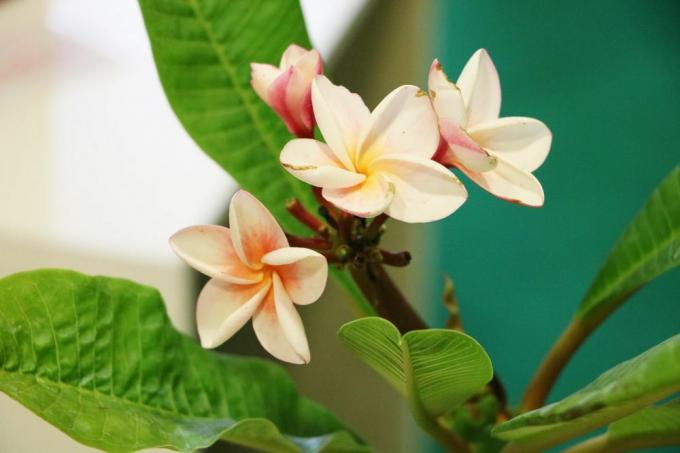
The temple tree can easily be propagated by cuttings or sowing. In addition, it should be known that no flower color can be predetermined when sowing. When propagating by cuttings, white and yellow blooming temple trees show up as the more suitable mother plants of cuttings, since they take root better.
Cuttings
- best time to propagate: spring between May and early June
- suitable shoots: thick and woody
- Shoot / cuttings length: approx. 25 centimeters
- Cut the shoot straight off and let it dry for two to three days
- After the interface has dried, place the shoot in a translucent glass
- Add about five centimeters of lukewarm water
- water change every other day
- Location: bright (no direct sunlight)
- Ambient temperature: around 20 degrees Celsius
- Root formation: between two and three weeks
- Plant in a pot when the roots that have formed are a few centimeters long
sowing
- Best time for propagation by sowing: May / June - by the end of July at the latest
- Sow outside the specified time only with artificial plant light
- Soak seeds in lukewarm water 48 hours before sowing
- Fill a suitable pot or seed box with potting soil
- Cultivation soil should be mixed with coarse sand or coconut fibers (promotes moisture retention)
- Spread seeds on the surface of the earth and cover lightly with soil (dark germinator)
- watering (spraying prevents the seeds from floating on the surface due to the water pressure during watering)
- Stretch translucent plastic film over the pot / box
- Open the foil for ventilation and watering every other day (keep soil moisture continuously)
- Location: sunny-bright
- Ambient temperatures: around 25 degrees Celsius
- Germination time: between seven and 14 days
- Prick out: five to eight weeks after germination
Diseases

sunburn
If the leaves and especially the tips of the shoots turn brown and dry out, the plumeria must be put in the shade and the affected parts of the plant cut off. When it is put back in the open after wintering, the plant should slowly get used to the warmth.
Stem rot
The stem rot is caused by an algae fungus. There are glassy areas on the trunk, which is becoming increasingly soft. In order to save a plant affected by the algae fungus, a fungicide should be used and a radical cut should be carried out at the same time.
Root rot
Root rot occurs on the temple tree especially during the winter dormancy. This usually arises because too much care is taken in terms of irrigation and is not taken into account that is because of the lower temperatures and shutdown of the metabolism of the water requirement sinks. In the early stages of the disease, planting out, drying the roots and cutting off completely soggy and moldy root parts helps here.
Pests
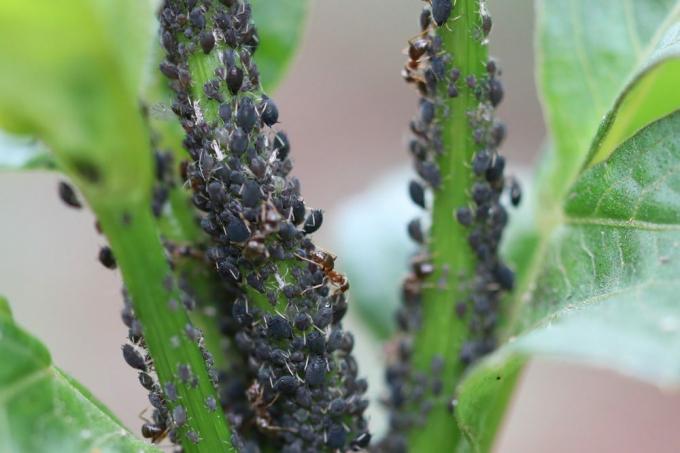
Various people sat on the temple tree Pests gladly off to feed on the sap. In most cases, it is important to combat them quickly so that they do not infect neighboring plants and, in the worst case, cost a frangipani its life. The most common parasites include:
- Aphids
- Spider mites
- Thrispen
- Whiteflies
- Mealybug
Combat
Lice and Thrispen
The quickest and easiest way to combat these pests is with an insecticide. Alternatively, and in a more environmentally friendly way, lice and thrips can be treated with soapy water, which is simply sprayed over the entire plant.
Spider mites
Spider mites become active when it is dry. To get rid of them, the infected plumeria should be briefly exposed to high humidity. To do this, shower the plant vigorously and cover it with plastic film for two to three days.
Whiteflies
The whitefly can be fought reliably with natural enemies, such as the ichneumon fly, for which the whitefly is a delicacy. These can be lured into the garden or obtained from specialist retailers.



